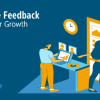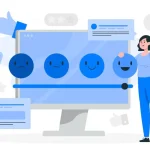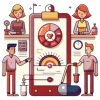
Cultivating a Patient-Centric Culture with Real-Time Feedback and Surveys
Building a strong patient-centric culture in healthcare is vital. Using real-time feedback and surveys, organizations can respond swiftly to patient needs. This approach not only improves satisfaction but also elevates the quality of care.
But how can healthcare providers implement this strategy effectively? Let’s explore the steps to foster a patient-centric culture using real-time feedback.
What is a Patient-Centric Culture
A patient-centric culture places the patient at the core of all healthcare activities. Every decision, process, and interaction revolves around the patient’s needs, preferences, and expectations. This culture promotes patient autonomy, improves satisfaction, and leads to better outcomes.
By focusing on what patients want and need, healthcare providers can deliver more personalized and effective care. To cultivate this culture, healthcare organizations must integrate patient feedback into their operational processes.
Real-time feedback mechanisms, such as surveys, offer valuable insights into the patient experience. These insights allow for quick adjustments, ensuring that care remains aligned with patient expectations.
A strong patient-centric culture not only benefits patients but also enhances staff morale and institutional reputation.
Role of Real-Time Feedback
Real-time feedback is a critical component in building a patient-centric culture. It provides immediate insights into patient experiences, enabling healthcare providers to address issues as they arise.
Unlike traditional feedback methods that may take weeks or months to process, real-time feedback offers instant data. This immediacy allows for swift corrections, ensuring that patient concerns are addressed promptly.
Real-time feedback can be collected through various means, including digital surveys, mobile apps, and direct communication. These tools make it easier for patients to share their experiences, leading to more accurate and timely insights.
Moreover, this feedback fosters transparency, as patients see that their voices are heard and acted upon. In turn, this builds trust and encourages ongoing engagement with the healthcare provider.
Implementing Real-Time Feedback Systems
To implement real-time feedback systems, healthcare providers must first choose the right tools. Digital surveys are among the most effective methods for gathering real-time feedback. These surveys can be sent via email, text message, or mobile app, making it convenient for patients to respond.
The questions should be clear, concise, and focused on key aspects of the patient experience. Another effective tool is the use of patient portals, where individuals can easily provide feedback on their care.
These platforms often allow for instant messaging with healthcare providers, enabling immediate response to concerns. Additionally, implementing feedback kiosks in clinics or hospitals can capture patient input right after their visit, providing real-time data that can be used to improve service quality.
Once the feedback is collected, it should be analyzed quickly to identify trends and areas for improvement. This analysis can be done through automated systems that categorize and prioritize feedback, making it easier for healthcare teams to respond effectively.
Sharing this feedback with staff and using it to guide training and process improvements further reinforces a patient-centric culture.
Surveys: A Powerful Tool for Patient Engagement
Surveys play a crucial role in cultivating a patient-centric culture. They provide a structured way to gather patient insights, helping healthcare providers understand their experiences better. When designed well, surveys can reveal patterns in patient needs and preferences, guiding more personalized care.
To maximize the effectiveness of surveys, they should be kept short and focused. Patients are more likely to complete surveys that respect their time and get straight to the point. Questions should cover key aspects of the patient experience, such as the quality of communication.
The clarity of information provided, and the overall satisfaction with the care received. Using both quantitative and qualitative questions can provide a well-rounded view of the patient experience. Quantitative questions, such as rating scales, offer measurable data that can be tracked over time.
Qualitative questions, such as open-ended prompts, allow patients to share more detailed feedback in their own words. This combination helps healthcare providers gain a deeper understanding of patient needs.
Integrating Real-Time Feedback with Surveys
Combining real-time feedback with surveys enhances the ability to cultivate a patient-centric culture. While real-time feedback captures immediate responses, surveys offer more comprehensive insights. Together, they provide a fuller picture of the patient experience.
Allowing for both quick fixes and long-term improvements. For example, real-time feedback might reveal an issue with appointment scheduling, prompting an immediate adjustment. A follow-up survey could then assess whether the change has improved patient satisfaction.
This iterative process ensures that the healthcare provider is continually refining its services to better meet patient needs. Integrating these tools into a unified system can also streamline the feedback process.
Patients can be prompted to complete a survey after providing real-time feedback, offering them an opportunity to elaborate on their initial comments. This approach not only enhances the quality of the feedback but also reinforces the patient’s role in shaping their care.
Overcoming Challenges in Cultivating a Patient-Centric Culture
Cultivating a patient-centric culture with real-time feedback and surveys is not without challenges. One of the primary obstacles is ensuring consistent patient participation. Patients may feel overwhelmed by frequent requests for feedback, leading to lower response rates.
To address this, healthcare providers must strike a balance between collecting sufficient data and avoiding patient fatigue. Another challenge is integrating feedback into everyday practice. Real-time feedback and surveys are only valuable if they lead to actionable insights.
Healthcare providers must be committed to using this data to drive changes in care delivery. This requires a culture of continuous improvement, where staff are encouraged to innovate and adapt based on patient feedback.
Additionally, privacy concerns may arise when collecting real-time feedback. Patients need to feel confident that their information will be kept confidential and used responsibly. Clear communication about how feedback will be used and the measures in place to protect patient data can help alleviate these concerns.
Impact of a Patient-Centric Culture on Healthcare Outcomes
A strong patient-centric culture, supported by real-time feedback and surveys, can have a profound impact on healthcare outcomes. Patients who feel heard and respected are more likely to engage in their care, leading to better adherence to treatment plans.
This engagement can result in improved health outcomes, as patients are more likely to follow through with recommended treatments and lifestyle changes. Moreover, a patient-centric culture can reduce the likelihood of medical errors.
When patients are actively involved in their care, they are more likely to catch mistakes or discrepancies. Real-time feedback can also alert healthcare providers to potential issues before they escalate, allowing for swift intervention. Patient satisfaction is another key outcome of a patient-centric culture.
Satisfied patients are more likely to return to the same provider and recommend the service to others. This loyalty not only boosts the provider’s reputation but also contributes to financial stability, as repeat business and referrals are crucial in a competitive healthcare market.
Case Studies: Successful Implementation of Real-Time Feedback in Healthcare
Several healthcare organizations have successfully implemented real-time feedback and surveys to cultivate a patient-centric culture. These case studies provide valuable insights into best practices and demonstrate the tangible benefits of this approach.
One example is a large hospital system that integrated real-time feedback into its patient care processes. By using mobile apps and patient portals, the hospital was able to capture feedback immediately after appointments.
This data was analyzed daily, allowing the hospital to make rapid adjustments to care delivery. The result was a significant increase in patient satisfaction scores and a reduction in patient complaints. Another case study involves a primary care clinic that used surveys to track patient satisfaction over time.
The clinic identified trends in patient feedback, such as concerns about wait times and communication with staff. By addressing these issues, the clinic was able to improve its overall patient experience and saw a marked increase in patient retention rates.
These case studies highlight the importance of commitment and consistency in cultivating a patient-centric culture. Real-time feedback and surveys must be integrated into the fabric of the healthcare organization, with a clear focus on continuous improvement.
Strategies for Sustaining a Patient-Centric Culture
Sustaining a patient-centric culture requires ongoing effort and dedication. Healthcare providers must continually seek ways to enhance the patient experience, using real-time feedback and surveys as key tools in this process.
One strategy is to create a feedback loop, where patient insights are regularly reviewed and acted upon. This loop should involve all levels of the organization, from frontline staff to senior management. By making feedback a central part of decision-making.
Healthcare providers can ensure that patient needs remain at the forefront of their operations. Another important strategy is to invest in staff training and development. A patient-centric culture thrives when staff are equipped with the skills and knowledge to deliver exceptional care.
Training should focus on communication, empathy, and responsiveness, helping staff to better understand and meet patient expectations.
Finally, healthcare providers should celebrate successes and learn from challenges. Sharing positive feedback with staff can boost morale and reinforce the importance of a patient-centric approach. At the same time, analyzing negative feedback can lead to valuable insights and drive improvements.
Future of Patient-Centric Culture in Healthcare
The future of healthcare lies in the continued evolution of a patient-centric culture. As technology advances, the tools for collecting real-time feedback and conducting surveys will become even more sophisticated. Artificial intelligence and machine learning.
For example, can analyze large volumes of feedback quickly, identifying trends and patterns that might otherwise go unnoticed. Moreover, the integration of patient feedback into electronic health records (EHRs) will make it easier for healthcare providers to deliver personalized care.
By having a comprehensive view of the patient’s preferences and experiences, providers can tailor their approach to meet individual needs more effectively. In the coming years, patient-centric culture will also be shaped by increasing patient expectations.
As patients become more informed and empowered, they will demand higher levels of transparency and involvement in their care. Healthcare providers that embrace this shift and prioritize patient feedback will be better positioned to succeed in a rapidly changing industry.
Conclusion
Cultivating a patient-centric culture with real-time feedback and surveys is essential for delivering high-quality, personalized healthcare. By placing patients at the heart of every decision, healthcare providers can improve satisfaction, enhance outcomes, and build lasting trust.
While challenges exist, they can be overcome with a commitment to continuous improvement and a focus on meeting patient needs. As the healthcare landscape continues to evolve, those who embrace a patient-centric approach will be well-positioned to thrive.
Frequently Asked Questions (FAQs)
How Does Real-Time Feedback Contribute To A Patient-Centric Culture?
Real-time feedback provides immediate insights into patient experiences, allowing healthcare providers to address issues quickly. This responsiveness is key to maintaining a patient-centric approach.
Why Are Surveys Important In A Patient-Centric Culture?
Surveys offer structured insights into patient experiences, helping healthcare providers understand their needs better. They complement real-time feedback by providing more comprehensive data.
What Are The Challenges Of Cultivating A Patient-Centric Culture?
Challenges include ensuring consistent patient participation, integrating feedback into practice, and addressing privacy concerns. Overcoming these challenges requires a commitment to continuous improvement.
How Can Healthcare Providers Sustain A Patient-Centric Culture?
Sustaining a patient-centric culture involves creating a feedback loop, investing in staff training, and celebrating successes. Ongoing efforts are needed to keep patient needs at the center of care.
What Is The Future Of Patient-Centric Culture In Healthcare?
The future will see more advanced tools for collecting and analyzing patient feedback, greater integration with electronic health records, and rising patient expectations for involvement in their care.
Enhance Patient Care and NABH Compliance with LazyMonkey
LazyMonkey is your all-in-one solution for improving patient care, retaining more patients, and meeting NABH standards. Our powerful QR-based feedback tool enables you to capture real-time insights from patient feedback, discharge surveys, staff and doctor evaluations, and clinical research, while also streamlining inter-departmental communication.
Transform your healthcare facility today - reach out to us at hello@lazymonkey.in, or request a demo here!
Elevate Your Restaurant Experience with LazyMonkey
LazyMonkey’s QR-based feedback system helps you gather real-time insights from customers, track satisfaction levels, and enhance the dining experience. Get instant feedback on your menu, service, and ambience, and make data-driven improvements to boost repeat customers and reviews.
Improve your restaurant today – reach out to us at hello@lazymonkey.in, or request a demo here!
Empower Student Engagement and Campus Improvement with LazyMonkey
LazyMonkey offers a seamless way to gather student feedback, track satisfaction, and enhance campus life. From course evaluations to dorm feedback, our QR-based solution makes it easy to capture valuable insights and improve student retention.
Upgrade your university experience – contact us at hello@lazymonkey.in, or request a demo here!
Streamline Feedback and Drive Performance Across Your Enterprise/Franchise with LazyMonkey
Whether you manage one or multiple locations, LazyMonkey’s QR-based feedback system helps you gather real-time employee and customer feedback. Improve operational efficiency, track satisfaction, and make data-driven decisions to enhance brand consistency and growth.
Transform your franchise today – reach out to us at hello@lazymonkey.in, or request a demo here!
Enhance Customer Satisfaction and Service Standards in Banking with LazyMonkey
LazyMonkey empowers banks to capture real-time feedback from clients across branches. Improve customer experience, assess service quality, and ensure regulatory compliance with our QR-based solution, helping you retain clients and meet banking standards.
Elevate your bank’s customer care – contact us at hello@lazymonkey.in, or request a demo here!
Boost Customer Engagement and Mall Satisfaction with LazyMonkey
LazyMonkey’s QR-based feedback tool enables you to collect feedback from shoppers, track satisfaction, and enhance the mall experience. Gather insights on store services, cleanliness, and entertainment to create an unmatched customer journey.














